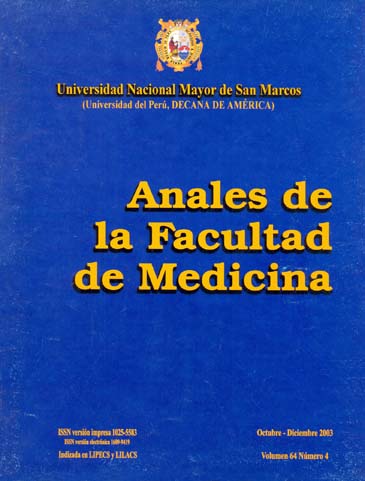Nutritional anemia and AIDS
DOI:
https://doi.org/10.15381/anales.v64i4.1422Keywords:
Anemia, acquired inmunodeficiency syndrome, nutrition disordersAbstract
Objectives: To determine the type of anemia most frequent in patients with AIDS and the various degrees of anemia. Material and methods: One hundred patients 18 to 60 year-old infected with human immune deficiency virus (HIV) with residence in Lima and Callao were studied from January to December 2001 for blood count bone marrow aspiration, serum iron, transferrin, ferritin, folate and vitamin B12 levels. Samples were evaluated at the “Dos de Mayo” Hospital Clinical Pathology Department. Results: From the 100 patients, 60% had severe, 30% moderate and 10% light anemia; 70% nutritional and 30% due to chronic disease. In the nutritional anemia group, 25% was ferropenic anemia, 30% ferropenic and megaloblastic (double defect) and 15% megaloblastic. In the megaloblastic anemia group, 30 patients had folate deficiency and 15 vitamin B12 deficiency. Conclusions: Prevalent anemia was nutritional. Anemia’s degree was frequently severe.Downloads
Published
2003-12-31
Issue
Section
Trabajos originales
License
Copyright (c) 2003 OSCAR RUIZ, DAVID DÍAZ, OSCAR CASTILLO, RAFAEL REYES, MANUELA MARANGONI, GERARDO RONCEROS

This work is licensed under a Creative Commons Attribution-NonCommercial-ShareAlike 4.0 International License.
Those authors who have publications with this magazine accept the following terms:
- Authors will retain their copyrights and guarantee the journal the right of first publication of their work, which will be simultaneously subject to Creative Commons Attribution License that allows third parties to share the work as long as its author and its first publication this magazine are indicated.
- Authors may adopt other non-exclusive licensing agreements for the distribution of the version of the published work (eg, deposit it in an institutional electronic file or publish it in a monographic volume) provided that the initial publication in this magazine is indicated.
- Authors are allowed and recommended to disseminate their work over the Internet (eg: in institutional telematic archives or on their website) before and during the submission process, which It can produce interesting exchanges and increase quotes from the published work. (See El efecto del acceso abierto ).
How to Cite
1.
Ruíz Óscar, Díaz D, Castillo Óscar, Reyes R, Marangoni M, Ronceros G. Nutritional anemia and AIDS. An Fac med [Internet]. 2003 Dec. 31 [cited 2025 Jun. 13];64(4):233-8. Available from: https://revistasinvestigacion.unmsm.edu.pe/index.php/anales/article/view/1422



